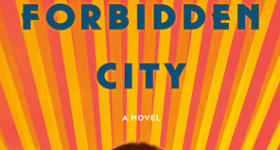The Asian American Literary Review (AALR) was immediately the most obvious inaugural choice to review for Hyphen's new column on literary journals. AALR, simply put, is one of the best publications out there, and we're not just talking Asian American literature. While most literary journals present a predictable lineup in their table of contents (containing a brief selection of poetry, short fiction, visual art, and the occasional book review or essay), AALR pushes boundaries in each issue, featuring original sections like its Forum (a series of interactive short essays between several writers about a given topic), as well as creative nonfiction, interviews, translations, musings, marginalia, electronic epistolaries and comic art.
Averaging at 250+ pages per issue, AALR is a hefty read that lets the reader indulge. Issues often feature more than the usual one or two pieces per writer. Readers get as many as six or more poems per poet, and regularly more than one short story per author. Interviews run for 50 pages or more (certain interviews, like the one of Garrett Hongo by Michael Collier even span as installments over three issues). Essays form a series of long dialogues among writers engaging with and building upon each others' ideas. Letter exchanges between writers take place over several months' time. Perhaps what makes AALR stand out among countless other literary journals is the thorough feeling it gives for each artist's work. Rather than just a quickie taste, we get to savor range and variety, and discover depths and overtones in each contributor's work.
Founded in 2010 and led by editors in chief Lawrence-Minh Bὺi Davis and Gerald Maa, the biannually-published AALR's mission statement intends the journal to be "a space for all those who consider the designation 'Asian American' a fruitful starting point for artistic vision and community." And indeed, the vision and community encouraged by the project is broad and inclusive, for it does not limit the term "Asian American" to an ethnic designation or geographical location, but considers diaspora and racial, ethnic, geographic and subject interconnectivity. Contributors include non-Asians and non-Americans, and topics are often approached and considered from interdisciplinary perspectives.
AALR's latest issue, themed "Speak No Evil," is easily one of its best ever. Unique in this issue are the sections "Dispatches from Hong Kong," a series of creative nonfiction essays about the umbrella revolution (written by various writers such as poet Collier Nogues, musician/poet/curator/coder/visual artist Adriel Luis, and translator/editor Lucas Klein), and A Lettre Correspondence between Arthur Sze and Ocean Vuong, which is borne out of AALR's program intended to mentor emerging API writers and strengthen ties across literary generations.
These two sections alone serve as examples of how AALR continually aims to broaden and test the scope of what can be considered as "literature" and "Asian American." The essays from "Dispatches," told from unexpected perspectives of American writer/translator/artist/editor expats as well as Hong Kong natives, encourage a cosmopolitan and international view of "Asian American." In many ways, such a view presents a notable contrast to more assimilationist attitudes held by some Asian Americans from earlier generations who eschewed direct connections or comparisons to native homelands. As reflected today in AALR entries, instead of insisting upon our American-ness at the cost of alienating Asian cultures, Asian Americans are now embracing dual fluency in both Western and Eastern inheritances and influences.
Similarly, the pairing of established Chinese American poet/translator Arthur Sze whose parents met in the U.S. as college students, and up-and-coming Vietnamese American poet Ocean Vuong whose family of illiterate farmers came to the U.S. after leaving Saigon in 1990, highlights the multiplicity of backgrounds within generations. In his opening letter, Vuong, uncannily wise for his mere 27 years, states:
I am starting to think that to be an Asian American is to build one's own nation -- within one's body. And maybe my best tools happen to be words and language. Through language, my nation remains malleable, ever changing, and borderless. My citizens are words and words belong to all who use them.
Ultimately, each AALR issue presents "Asian America" as a thriving force made up of communities of writers, intellectuals, social justice advocates, movement leaders and participants eager to search the creative process, engage in dialogue, work through conflict, confront challenges, take a stand, speak their minds and initiate change.
Mention must also be made of AALR's special issue on mixed race titled "Mixed Race in a Box." Instead of a hard copy issue, the reader will find beautifully packaged in a wooden box a collector's set consisting of a poetry poster ("A Mixology/Indigeneity"), playing cards (i.e., "race cards"), and three thick booklets. The booklets include "Mixed Race Is an Inbox" which contains essays and interviews (complemented by music, video and photography available online), "Mixed Race Is a Pandora's Box" which features poem-and-response articles (such as "'Enlightenment' and Time Present and Time Past" by Natasha Trethewey and W. Ralph Eubanks), narrative exchanges (such as "Piko/Crossings/Undulations/Ripple/Mo'o/Mauka" by Maya Soetoro-Ng and Alicia Upano), a play titled "Mixed Messages" by Michelle LaFlamme and Minelle Mahtani and even origami instructions by Lily Anne Yumi Welty and Tyrone Nagai titled "'Making' Mixed Race in Postwar Japan." Apropos of its topic, "Mixed Race in a Box" is hybrid in various ways, blending polyvocal points of view, interactive art and mixed media.
Go to AALR's website and subscribe now, not only to keep current on the latest discussions and developments in Asian American literature, but to be intellectually awakened, deeply engaged, delightfully surprised and greatly encouraged and inspired by the richness and dynamism within the Asian American literary community.










Comments